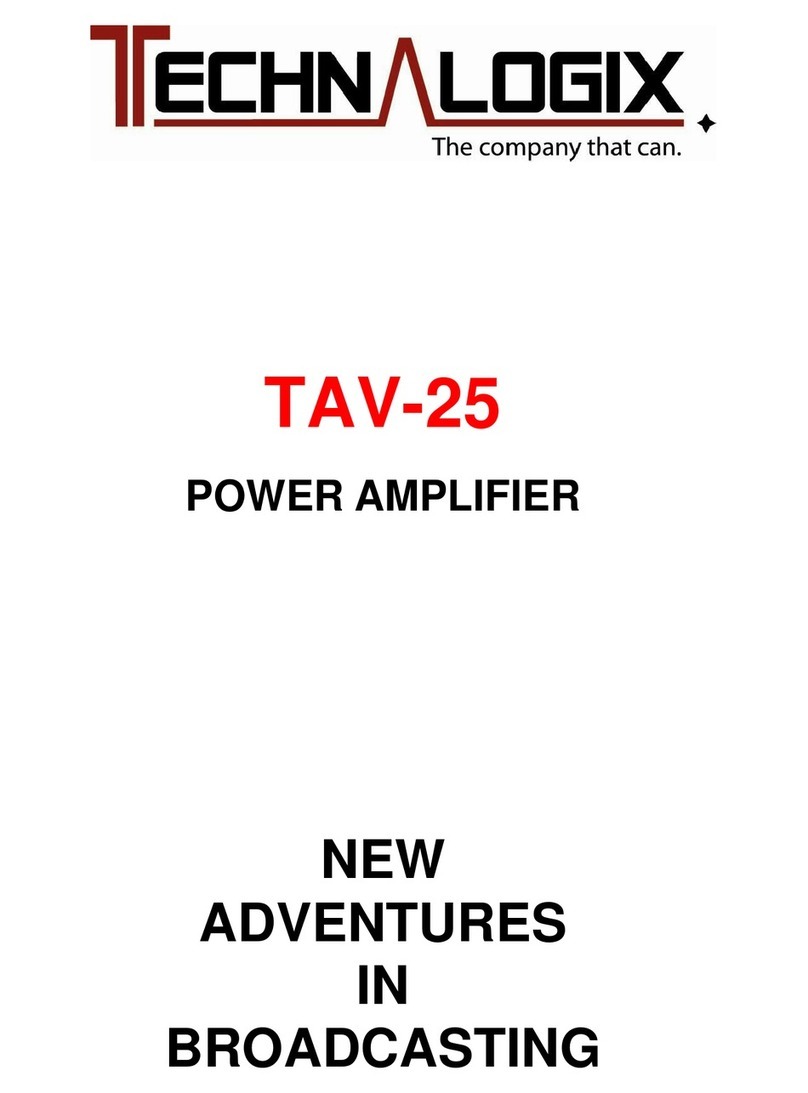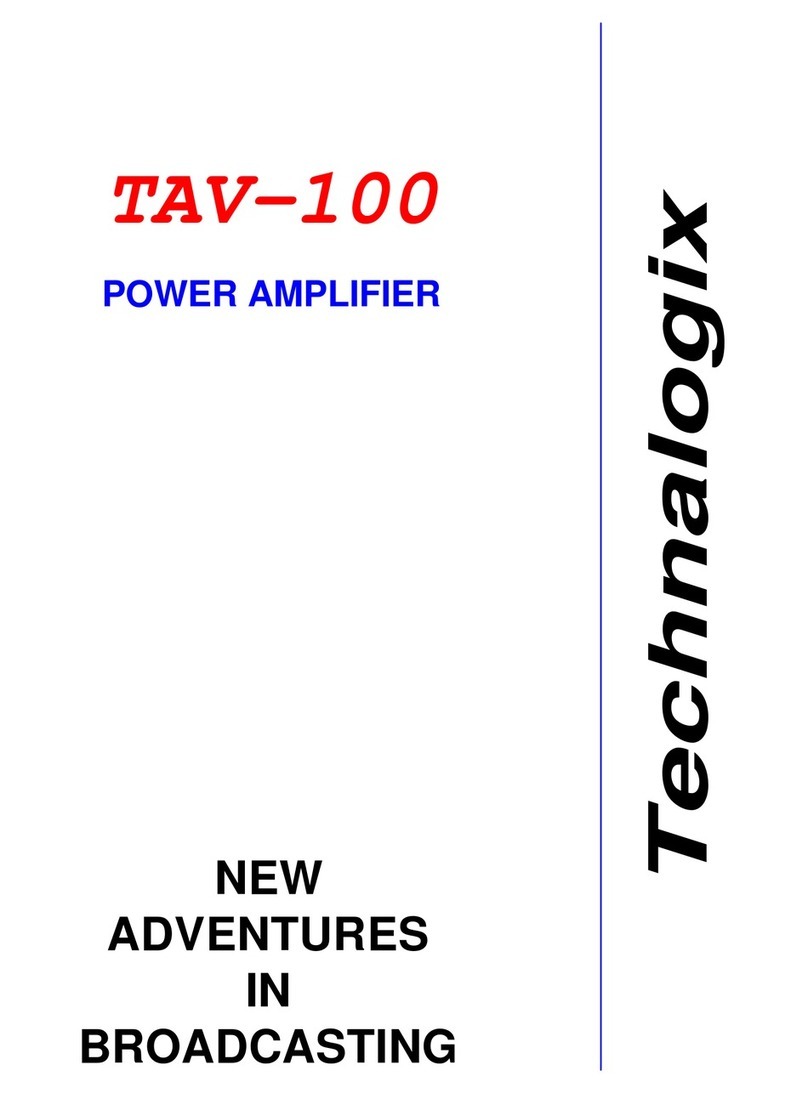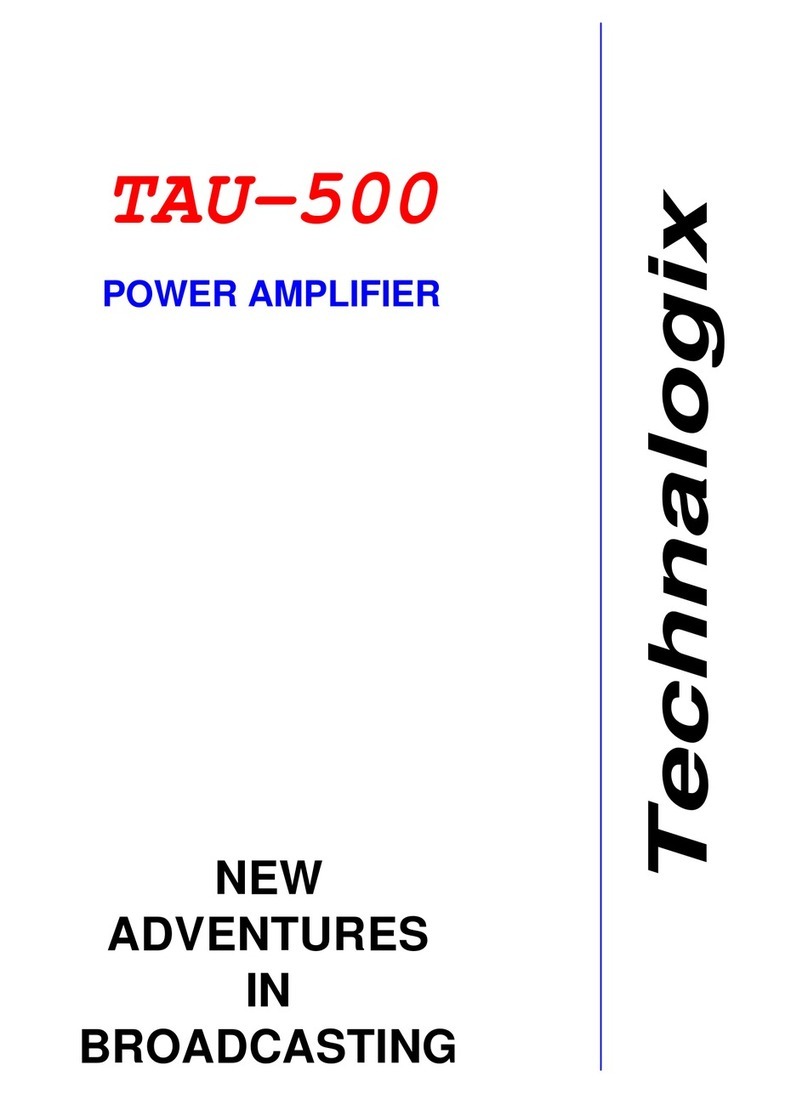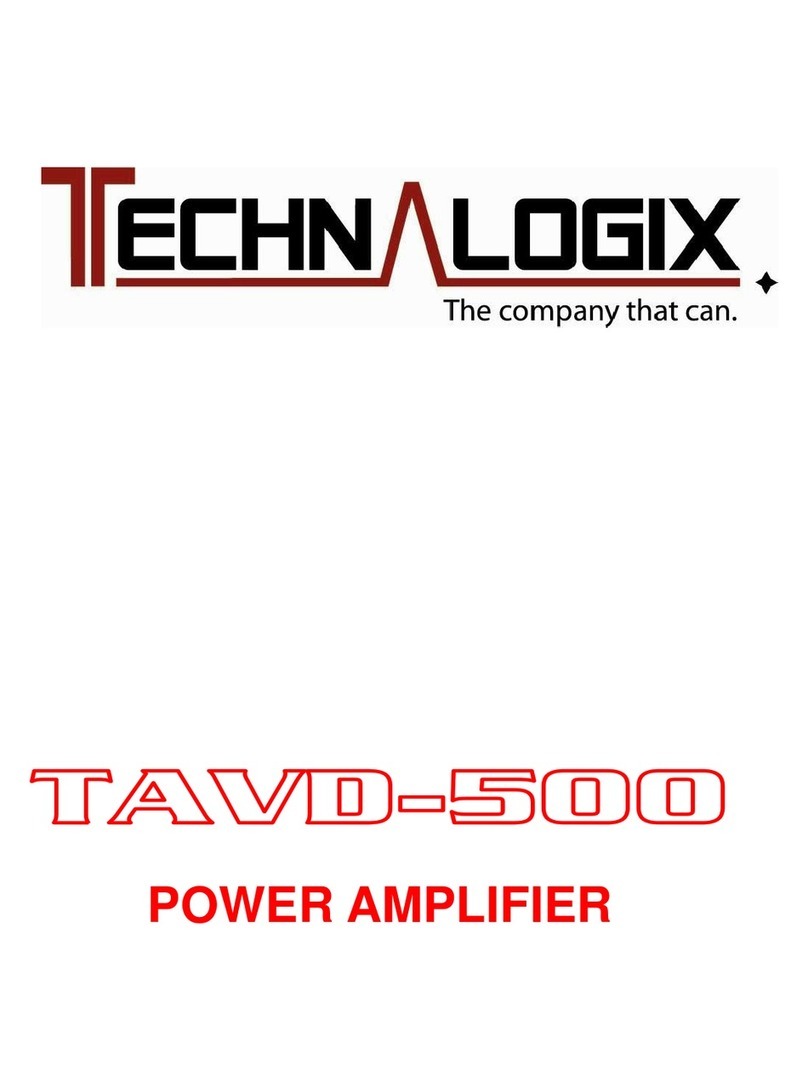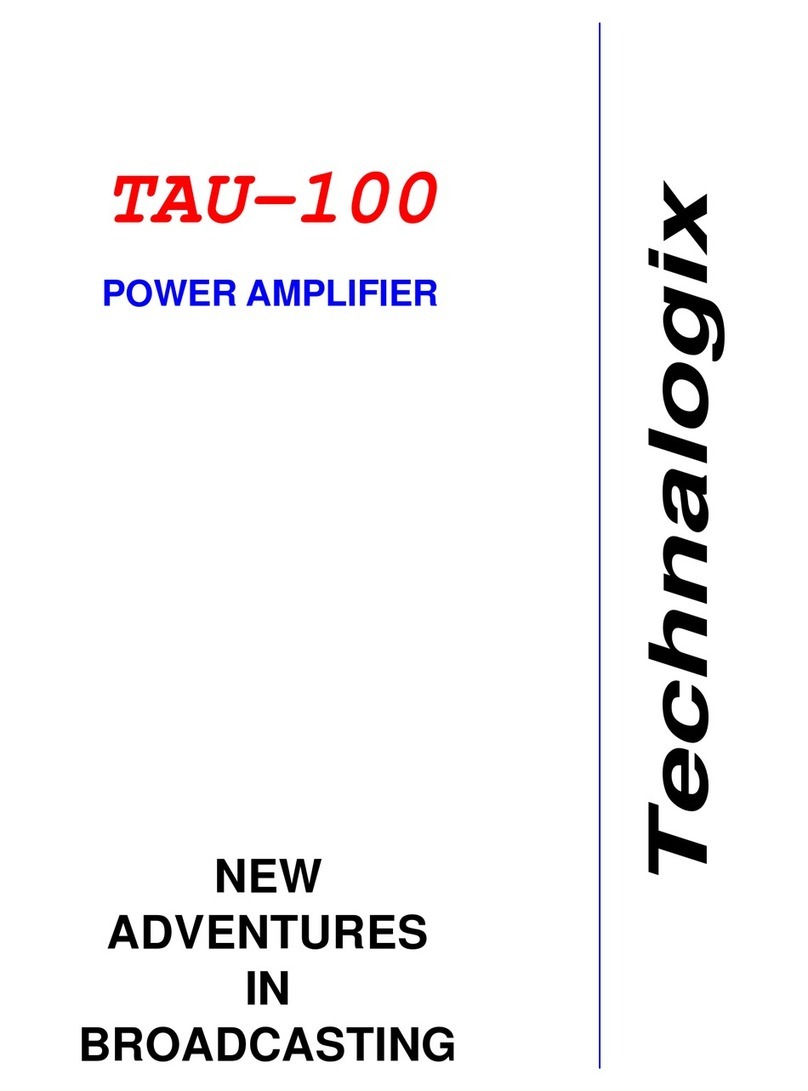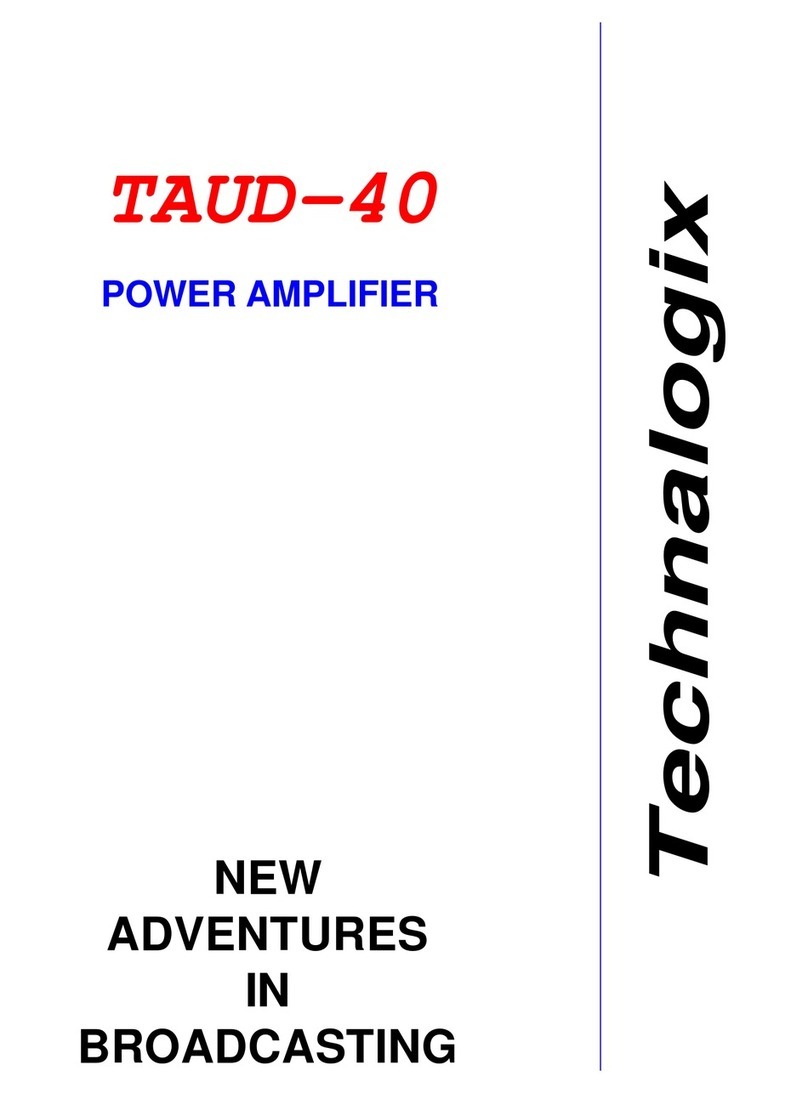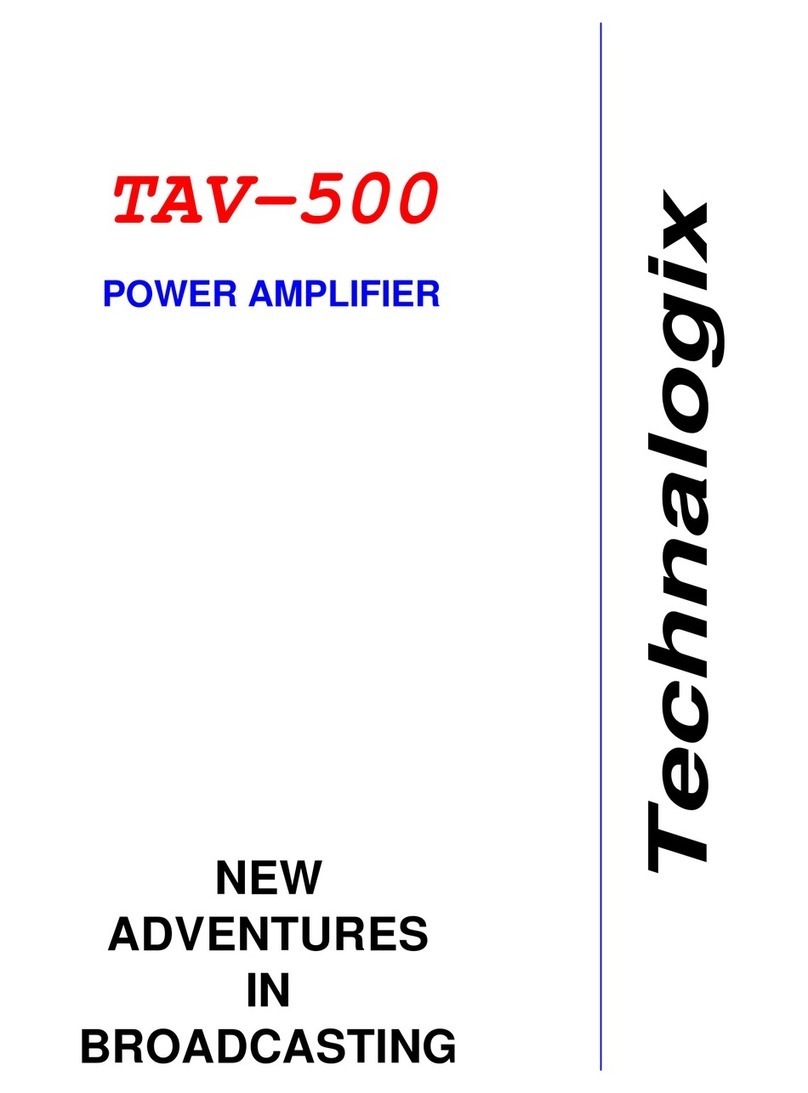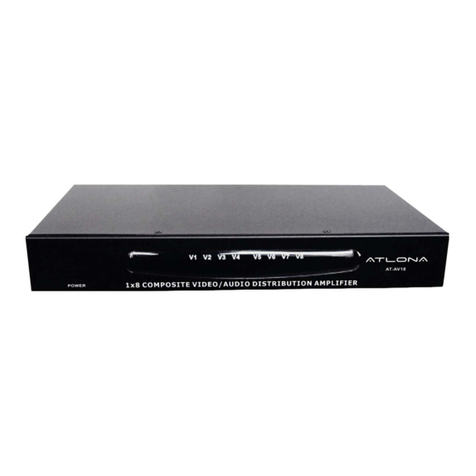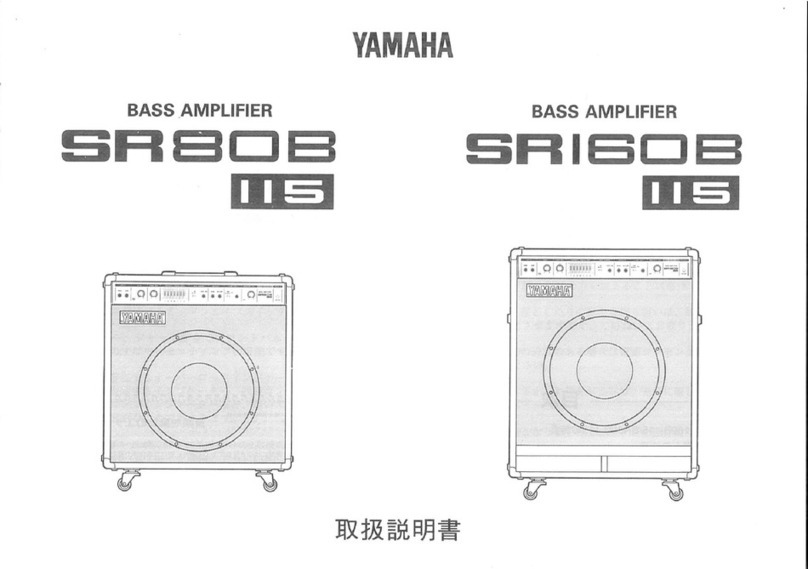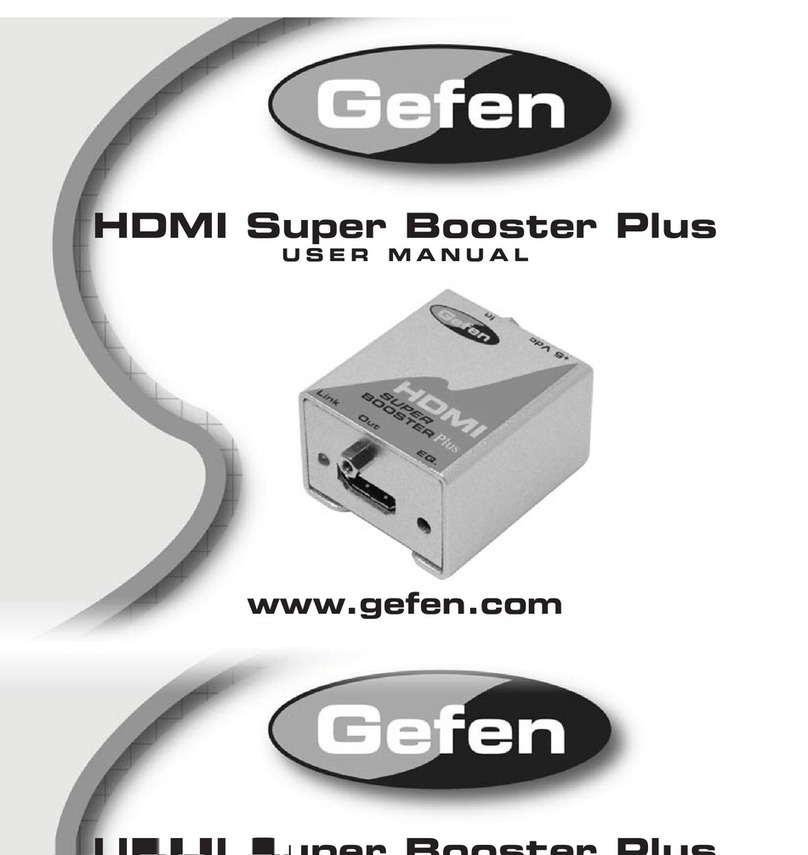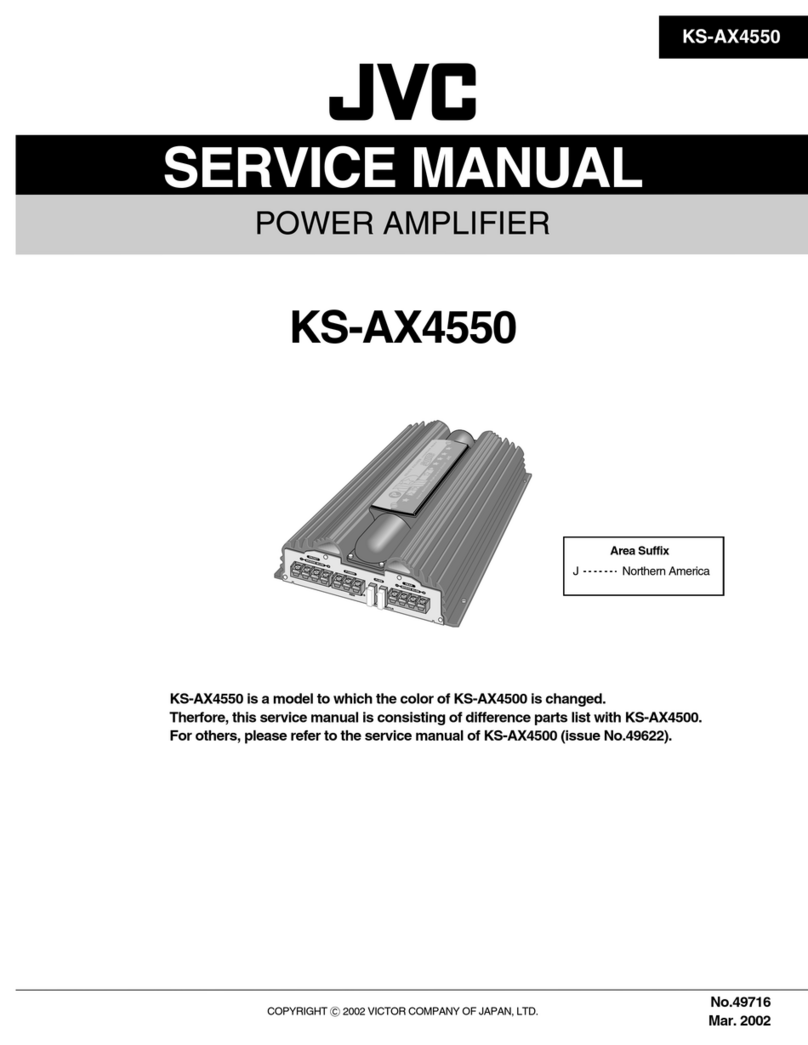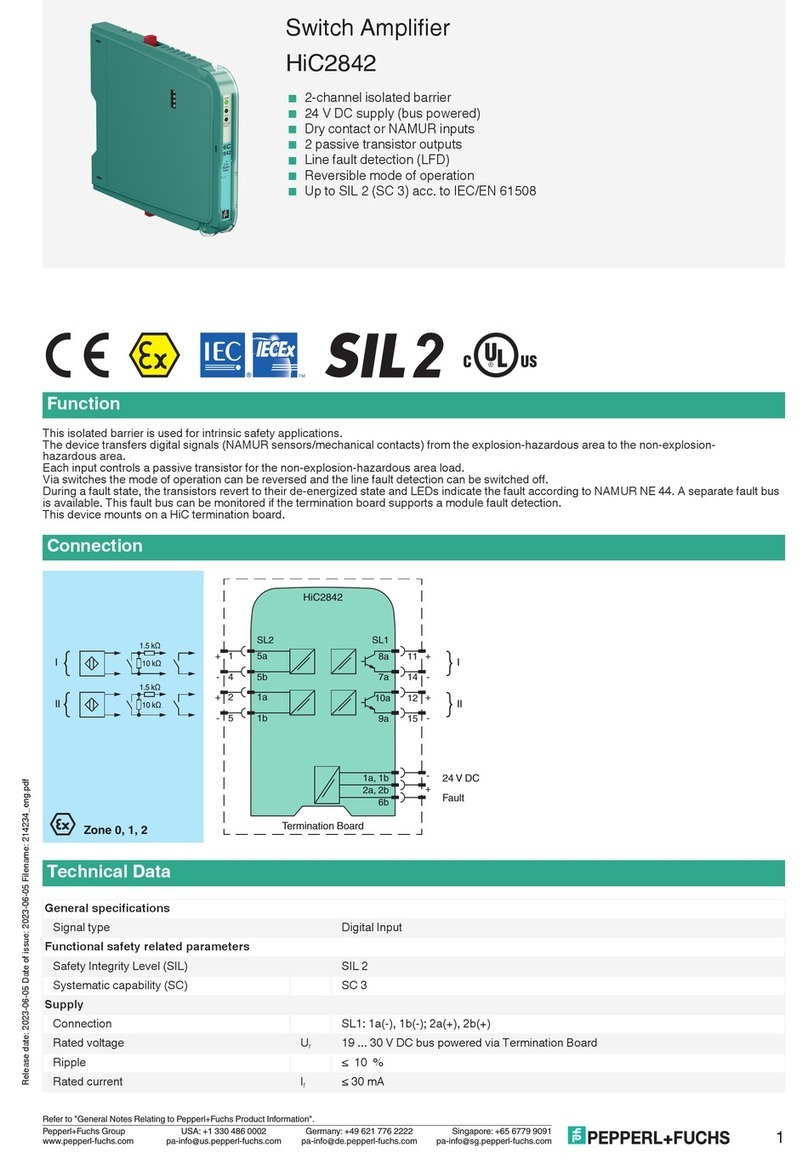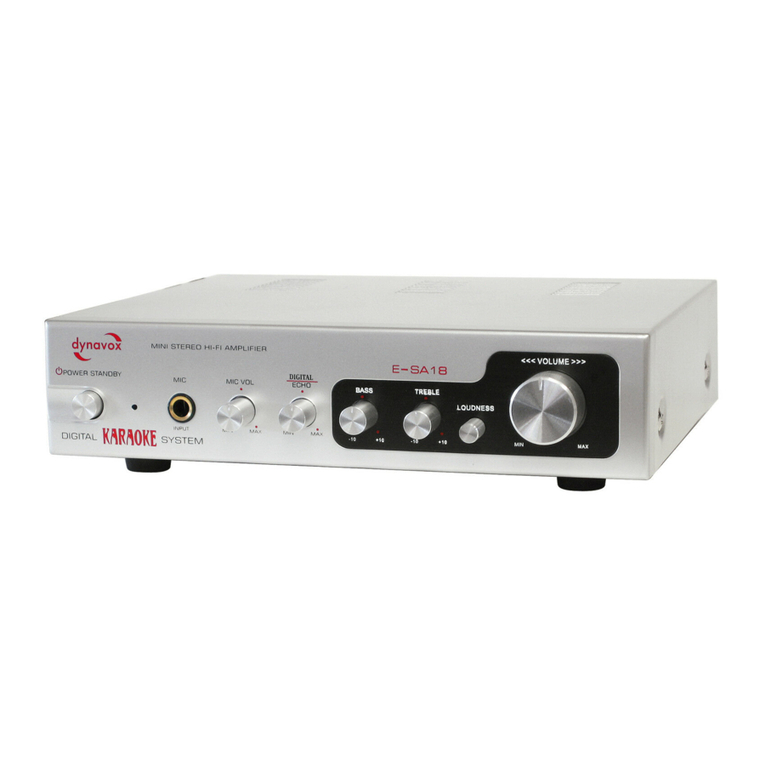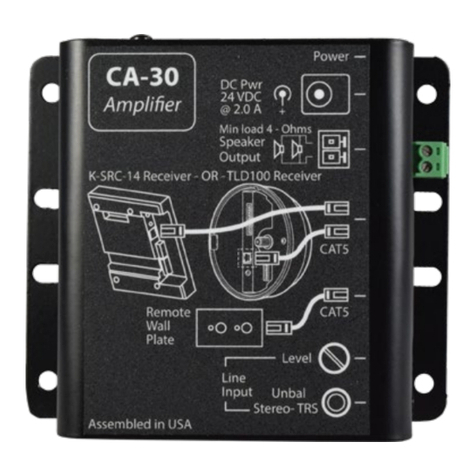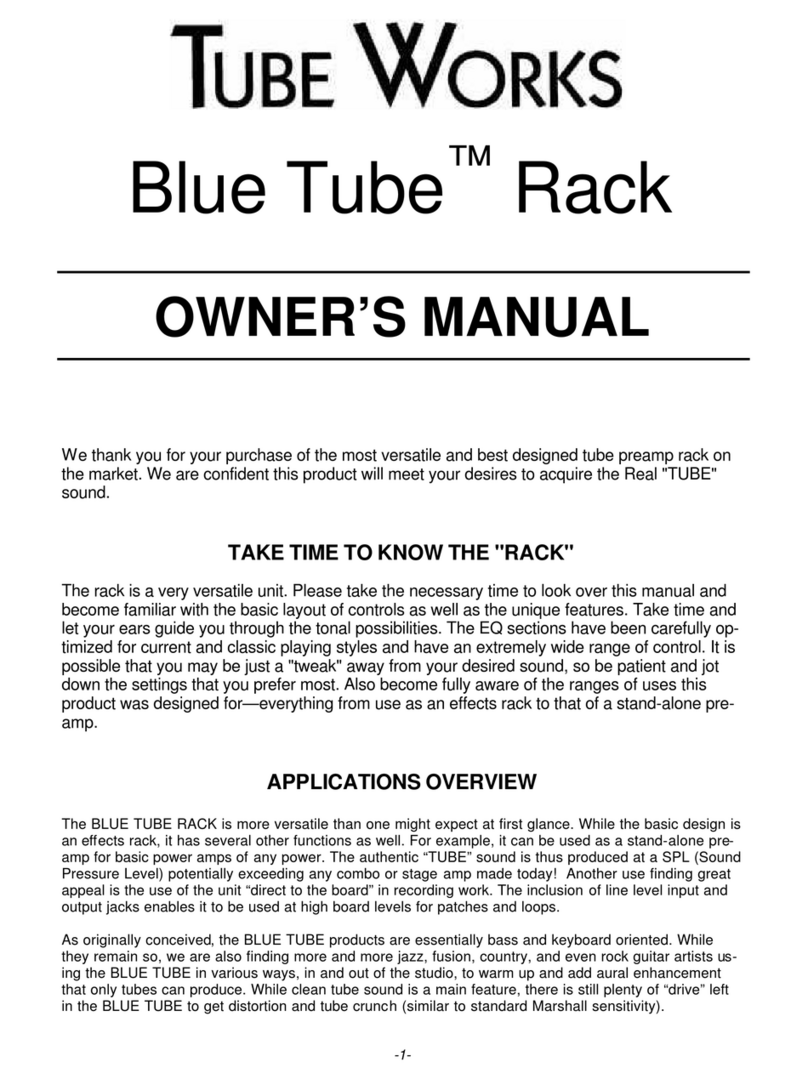Technalogix TAV-1000 User manual

TAV-1000
POWER AMPLIFIER
NEW
ADVENTURES
IN
BROADCASTING
Technalogix

You’ve already unpacked it, haven’t you? You’ve unpacked it and plugged
it in and turned it on and fiddled with the knobs.No?Okay,good. Please
take a few minutes to read the manual and familiarize yourself with your
new Technalogix power amplifier.
We believe that this manual, and of course our equipment, should be
everything you need to get on the air with superb broadcast quality video.
We understand that a capable and confident user will get the most out of
our product and we have made every attempt to educate readers of all
technical levels. If there is something that is not clear, or you require
further information, please do not hesitate to contact us and we’ll be glad
to help out.
Technalogix Ltd.
#4, 8021 Edgar Industrial Place
Red Deer, Alberta, Canada
T4P 3R3
Phone: 403.347.5400
Fax: 403.347.7444
URL: www.technalogix.ca
Email: [email protected]
We truly appreciate that you have chosen us as your television broadcast
system supplier. Happy viewing.

Table of Contents
SECTION I-SAFEGUARDS ..............................................................................................I-1
SAFETY AND FIRST AID.....................................................................................................I-2
OPERATING SAFEGUARDS ................................................................................................I-3
SECTION II -WARRANTY.............................................................................................II-1
SECTION III -OVERVIEW...............................................................................................III-1
STANDARD FEATURES.....................................................................................................III-1
PRINCIPLE OF OPERATION...............................................................................................III-2
BLOCK DIAGRAM (TAV-1000)........................................................................................III-3
BLOCK DIAGRAM (TAV-500)...........................................................................................III-6
BLOCK DIAGRAM (COMBINER/FILTER ENCLOSURE).......................................................III-8
SPECIFICATIONS...............................................................................................................III-9
SECTION IV -RF COMPONENTS................................................................................IV-1
AMPLIFIER PALLETS.......................................................................................................IV-1
SPLITTER/COMBINER.....................................................................................................IV-4
CIRCULATOR/ISOLATOR .................................................................................................IV-4
FINAL COMBINER............................................................................................................IV-5
DIRECTIONAL COUPLER.................................................................................................IV-5
FILTER............................................................................................................................IV-5
SECTION V -POWER SUPPLY SECTION......................................................................V-1
SECTION VI-MONITOR AND CONTROL SYSTEM.......................................................VI-1
CONTROL BOARD OVERVIEW (SERIES IIH)...................................................................VI-1
POWER SUPPLY COMPONENTS.....................................................................................VI-1
INTERFACE COMPONENTS .............................................................................................VI-2
SIGNAL CONDITIONING COMPONENTS ..........................................................................VI-3
DISPLAY COMPONENTS .................................................................................................VI-4
MICROCONTROLLER COMPONENTS...............................................................................VI-5
FAULT SHUTDOWN.........................................................................................................VI-6
ENCLOSURE INTERFACING.............................................................................................VI-7
REMOTE PORT...............................................................................................................VI-7
BILL OF MATERIALS.......................................................................................................VI-7
SCHEMATICS ..................................................................................................................VI-7

SECTION VII -MECHANICAL SECTION.......................................................................VII-1
SECTION VIII -INSTALLATION...................................................................................VIII-1
BUILDING RECOMMENDATIONS.....................................................................................VIII-1
HEATING AND COOLING REQUIREMENTS .....................................................................VIII-2
ELECTRICAL SERVICE RECOMMENDATIONS.................................................................VIII-3
ANTENNA AND TOWER RECOMMENDATIONS................................................................VIII-4
SHELTER SECURITY ......................................................................................................VIII-5
UNPACKING AND INSPECTION.......................................................................................VIII-6
LOCATION AND FUNCTION OF CONTROLS AND CONNECTORS (TAV-500 POWER
AMPLIFIERS)..................................................................................................................VIII-7
LOCATION AND FUNCTION OF CONTROLS AND CONNECTORS (COMBINER/FILTER
ENCLOSURE).................................................................................................................VIII-9
INITIAL HOOK UP.........................................................................................................VIII-11
SECTION IX -OPERATING PROCEDURES...................................................................IX-1
SECTION X-MAINTENANCE AND TROUBLESHOOTING...............................................X-1
TROUBLESHOOTING ........................................................................................................X-2

I-1
Section I -Safeguards
General Safeguards
This section is written as a general guide to keep all 5 fingers on your hand and is intended for those having
previous knowledge and experience with these kinds of equipment. It is not intended to contain a complete
statement of all safety precautions, which should be observed by personnel using this or other electronic
equipment.
DOCUMENTATION -Read, retain and follow instructions before operating the equipment. There is a
lot of useful information in the manual, and besides, we spent a lot of time writing it!
ENVIRONMENT -To reduce the risk of fire or electric shock, do not expose this equipment to rain,
moisture, or rye and sodas at the company Christmas party. Refer all servicing to qualified service
personnel.
SERVICING -Do not attempt to service this equipment yourself as opening or removing covers can
result in a warm tingly feeling and will void the warranty. Refer all servicing to qualified service
personnel.

I-2
Safety and First Aid
Personnelengagedintheinstallation,operation,maintenance, or servicing of electronicequipment are exposed
to the hazard of high voltage. It is imperative that all safety regulations and precautions are consistently
observed. Knowledge of first aid procedures is recommended. The following information is presented as a
reference only.
•Atall times, avoid placing any part ofthe body in series between ground and circuit points, whether power is
on or off.
•Dangerous voltage may be present in equipment even though power is off. Do not open the cabinet. Refer
servicing to qualified service personnel.
•It is the duty of all personnel to be prepared to give adequate emergency first aid treatment and thereby
prevent avoidable loss of life.
•There are three principle degrees of burns, recognizable as follows:
•a first-degree burn reddens the skin.
•a second-degree burn blisters the skin.
•a third degree burn chars the flesh and frequently places the victim in a state of shock accompanied
by respiratory paralysis.
•Respiratory paralysis can cause death by suffocation within seconds. It is imperative that the approved
methods of artificial respiration are initiated immediately and continue until the victim’s breathing is normal.
•A muscular spasm of unconsciousness may render the victim unable to break free of the electric power. If
this is the case, turn the power off immediately.
DO NOT TOUCH THE VICTIM OR YOU MAY SHARE THE SAME PREDICAMENT.
•If the power cannot be turned off immediately, very carefully loop a dry rope, article of clothing, length of
strong cloth or a rolled-up newspaper around the victim and pull the victim free of the power source.
Carefully avoid touching the victim or clothing.
•Once free of the power source, the victim must be placed in a reclining position and covered with a
blanket or newspapers to keep warm. At the first opportunity, enlist help in summoning a doctor. If a
doctor cannot be summoned, transport the victim to the doctor or a hospital. Be sure the victim is kept
well covered and warm while awaiting professional treatment.

I-3
Operating Safeguards
It is a known fact that our broadcast transmitters and translators enjoy 50-ohm load impedances. So much
so, that it is imperative you maintain 50-ohm impedances throughout your system. In return, your equipment
will provide you with maximum power transfer to the antenna and decreased reflected power heading back
towards the amplifier pallets, reducing the amount of magic smoke that gets let out of the power amplifier.
Before anything is turned on, ensure that there is a 50-ohm path from the output of each stage to the input
of the next, all the way to the antenna.
In addition to maintaining proper 50-ohm impedances throughout the signal chain, it is also important,
whenever possible, to make sure the RF drive going to the input of the power amplifier is removed before
turning on or turning off the DC power supply. This is because all of the RF transistors used in the individual
amplifier pallets are fabricated with LDMOS (Laterally Diffused Metal Oxide Semiconductor) technology.
Nice and linear yes, but they do not like to make any RF power when their supply voltages are not within a
specific range. When you first turn your power amplifier on or off, the DC power supply’s output voltage may
take a while to stable out to a safe operating voltage. Ten seconds wait before applying the RF drive will
ensure no issues arise.
Our power amplifiers are designed to reliably generate a specific RF output power. Failing to adhere to
overdriven amplifier warnings can decrease the reliability of your system, and frankly, makes our repair
department busy and grumpy. If you need to transmit to a little larger coverage, you are better off increasing
antenna gain, and more importantly, antenna height above average terrain. On TV and FM broadcast
frequencies, insufficient antenna height puts an upper limit on your range, regardless of power levels, as the
distance from your antenna to the radio horizon is limited.

II-
1
Section II -Warranty
Our legalese is straightforward. It is simply designed to give you peace of mind and helps you resist the
temptation to have your electronics friend try to repair your Technalogix product.
Technalogix Ltd. products have been completely tested and found to meet specifications and be in proper
operatingcondition. They are warranted to be freefrom defects in materials and workmanship fora period of one
year from the date of shipment. If the system becomes damaged in shipment and there are obvious signs of
damage to the outside of the packaging, notify your courier immediately before that courier walks out the door.
Technalogix Ltd. will not be liable for damages of whatever nature arising out of or in connection with the
equipmentor its usethereof. Technalogix doesnot assume responsibilityfor injury ordamage resulting fromthe
practices of untrained or unqualified personnel in the handling of this equipment.
Technalogix Ltd. warranty does not include:
•misuse, neglect or accident.
•incorrect wiring and /or improper installation.
•unauthorized repairs, modifications or use in violation of instructions issued by Technalogix.
•incidental or consequential damages as a result of any defect.
•reshipment cost or insurance of the unit or replacement units or parts.
•acts of nature or terrorism.
Technalogix agrees, at our option, to remedy warranted defects or furnish a new part in exchange for any part of
a unit which, under normal installation, use and service, becomes defective. The user will pay for transportation
costs to and from the repair center.

II-
2
To claim your rights under this warranty:
•Contact Technalogix and describe the problem in as much detail as possible. See troubleshooting section
in this manual. If a solution cannot be found at this time, it may be determined that the unit will have to be
returned to Technalogix for repair, once a Return Materials Authorization (RMA) number is provided.
•Package equipment carefully for prepaid shipment to Technalogix. Include a written description of the
problem experienced, a copy of the original invoice establishing warranty status, and the RMA.
Technalogix reserves the right to make revisions in current production of the equipment and assumes no
obligation to incorporate these changes in earlier models.
Shipping Address:
Technalogix Ltd.
ATTN: RMA#
#4, 8021 Edgar Industrial Place
Red Deer, Alberta, Canada
T4P 3R3
Ph: 403.347.5400
Made in Canada, returned for repairs

III-
1
Section III -Overview
Standard Features
•Narrow output bandpass filter allows adjacent channel operation
•Front panel Liquid Crystal Display (LCD) to monitor forward and reflected RF power, and DC voltage
•Microcontroller-based monitoring and control ensures amplifier will never be overdriven and high VSWR will
not damage amplifier
•AC circuit breaker on back panel to eliminate replacement of fuses
•All aluminium enclosure maintains power amplifier’s light weight
•Simple design using commonly available parts ensures reliable operation
•Predominate and third-order intermodulation distortion exceeds Industry Canada and FCC specification.

III-
2
Principle of Operation
The TAV-1000 power amplifier supplies a 1000-watt peak video signal with 10% aural power on any of the VHF
television channels 2 through 13. Please note that channel selection must be made at time of order, as the
transmitter or translator is calibrated and tested to the channel requested and is not field tuneable. The TAV-
1000 power amplifier is a modular solid-state 1000-watt broadcast amplifier utilizing readily available RF
components wherever possible, thus enhancing the serviceability of the equipment. The TAV-1000featuresultra
linear amplification andindividual channelRF output bandpassfiltering. Theamplifier modules arestable forhigh
reliability and long service life.
The amplification of the TAV-1000 is comprised of (2) TAV-500 500-watt power amplifiers. Firstly, the output of
the modulator or processor gets split into (2) RF signals of equal amplitude. Each output of the 2-way power
divider is then fed into a TAV-500 Power Amplifier. Finally, the outputs of each TAV-500 are combined to
generate 1000-watts of peak visual power in addition to an aural carrier, as seen in the TAV-1000 block diagram.

TO WATTMETER
AND ANTENNA
1U ENCLOSURE
5U ENCLOSURE
5U ENCLOSURE
5U ENCLOSURE
RF OUT
TAV-500
COMBINER
FILTER
TAV-500
SPLITTER
2-WAY
MODULATOR/PROCESSOR
TAV-1000 Overall Block Diagram
Date: December 17, 2003 Page: 1 of 1
Rev ID

III-
4
Inside each 500-watt power amplifier, the signal gets split into (2) signals for final amplification using a 2-way
Wilkinson power divider. The final amplification stage is comprised of (2) P400-VHF-L or (2) P400-VHF-H
final amplifiers, for low or high band VHF, respectively. The outputs of the (2) final amplifier pallets are
combined with a 2-way Wilkinson combiner and pass through a dual directional coupler for protection and
monitoring purposes, as illustrated in the following TAV-500 block diagram.

A=-0.05dB typ.
A=-0.5dB typ.
A=-0.08dB typ.A=-0.08dB typ.
GAIN
COMPENSATION ι
PA1 OUT
PA2 OUT
A=40dB typ. low band VHF
A=34dB typ. high band VHF
A=18dB typ. low band VHF
A=15dB typ. high band VHF
A=18dB typ. low band VHF
A=15dB typ. high band VHF
RF INPUT
RF OUT
PA25-VHF DRIVER SPLITTER
2-WAY P400-VHF FINAL
P400-VHF FINAL
2-WAY
COMBINER
VV
DIRECTIONAL COUPLER
V
CIRCULATOR
TERMINATION
50 OHM
TAV-500 Block Diagram for use with TAV-1000 Power Amplifiers
Date: December 17, 2003 Page: 1 of 2
Rev ID

III-
6
After amplification, the signal exits the power amplifier enclosure and goes into the combiner/filter enclosure,
where the signals from each 500-watt amplifier are combined. After combining, the amplified signals are
filtered with a bandpass filter and monitored again with another directional coupler before heading out to an
antenna for broadcast, as depicted in the following combiner block diagram.

A=-0.6dB to -1.0dB A=-0.05dB
A=-0.45dB
TO WATTMETER
AND ANTENNA
RF OUT
PA2 OUT
PA1 OUT
2-WAY
COMBINER
VV
COUPLERDIRECTIONAL
U2
Bandpass Filter
TAV-1000 Combiner Enclosure Block Diagram
Date: December 17, 2003 Page: 1 of 1
Rev ID

III-
8
Specifications
Thefollowing specificationswere taken witha Technalogixmodulator/processor. Should adifferent modulatoror
processor be used, specifications could vary. For this reason, we recommend that any different
modulator/processor be shipped to Technalogix so the system can be matched and set up optimally. In
addition, the audio/video ratio the input to the power amplifier needs to be –10 dB in order for the software and
LCD readout to be accurate. All specifications below were taken with the audio/video ratio set -10dB.
RF Characteristics
Frequency range any specified VHF Channel 2 to 13
Frequency Response (one channel) ±0.5 dB
Frequency Stability ±250 Hz
Selectivity 60 dB (adjacent channel)
Minimum Input Level 0 dBmV
Rated Visual Output Power 1000 Watts
Rated Aural Output Power 10% of peak visual power
IF Output Level -12 dBm nominal
Input Impedance 75 Ohms
Output Impedance 50 Ohms
Harmonics > 60 dB below rated power
Predominant Intermodulation Distortion dBc = decibels below visual carrier
+ 920 kHz > -53 dBc
-920 kHz > -53 dBc
+ 2.66 MHz > -53 dBc
-2.66 MHz > -53 dBc
+ 5.42 MHz > -53 dBc
+ 7.16 MHz > -53 dBc
3rd Order Intermodulation Distortion
-4.5 MHz > -60 dBc
+ 9.0 MHz > -60 dBc
All others > -60 dBc
Spurious Emissions > -60 dBc
NTSC Video Characteristics
Input Level to modulator (for 87.5% modulation) 1.0 VPP (100IRE + 40IRE sync)
Differential Phase (at 87.5% modulation) ±2 Degrees
Differential Gain (at 87.5% modulation) 2%
Group Delay < ±40 nS
Video Group Delay Pre-emphasis Conforms to IC/FCC specifications
K-Factor 1.9% for 2T Pulse
Hum and Noise > 60 dB below rated power
Aural Characteristics

III-
9
Input Level for 25 kHz Deviation 0.3 VPP
Frequency Response (Standard Pre-emphasis) ±1 dB
Harmonic Distortion (25 kHz Deviation) < 1% 50 Hz to 15 kHz
Amplitude Modulation Noise > 50 dB
Frequency Modulation Noise > 60 dB
Intercarrier Stability ±250 Hz
Physical Characteristics
Power Requirements
Power Supply 230 VAC, 30 AAC
Combiner / Filter 115 VAC, 2 AAC
Operating Temperature Range 0°C to 50°C
Dimensions
TAV-500 Power Amplifier (each) W-19" flange (17” encl.) , D-25", H-8 3/4” (5U)
Combiner / Filter W-19" flange (17” encl.) , D-25", H-8 3/4” (5U)

IV-1
Section IV –RF Components
Amplifier Pallets
The PA25-VHF pallet is a two stage ultra linear class-A linear pallet. The PA25-VHF-L has a typical gain of
40dB and the PA25-VHF-H has a typical gain of 34dB. These pallets draw no more than 3.0Adc total drain
current (the exact bias and drain currents of your system are found in the spec sheet supplied with each
manual). The quiescent and drain currents can be measured on the PA25-VHF pallet by measuring the voltage
drop across the current sense resistor found directly at the DC power supply lead input to the pallet. This
resistance is 0.01-ohms, providing a 10mV per ampere ratio.
The final amplifier stages are comprised of (2) P400-VHF-L or P400-VHF-H amplifier pallets and are each
characterized with minimum gains of 18 dB (low band) or 15 dB (high band) and maximum drain currents of
28 A (low-band) or 20 A (high-band).
All currents on the driver and final stages can be measured across the on-board shunt resistor (0.01-ohm)
found at the DC supply inputs. With this resistance, a 1mV reading across this resistor indicates a current
draw of 1.0A.

Table of contents
Other Technalogix Amplifier manuals
Popular Amplifier manuals by other brands

Sony
Sony XM-5150GSX Marketing Specifications, Connections... Service manual
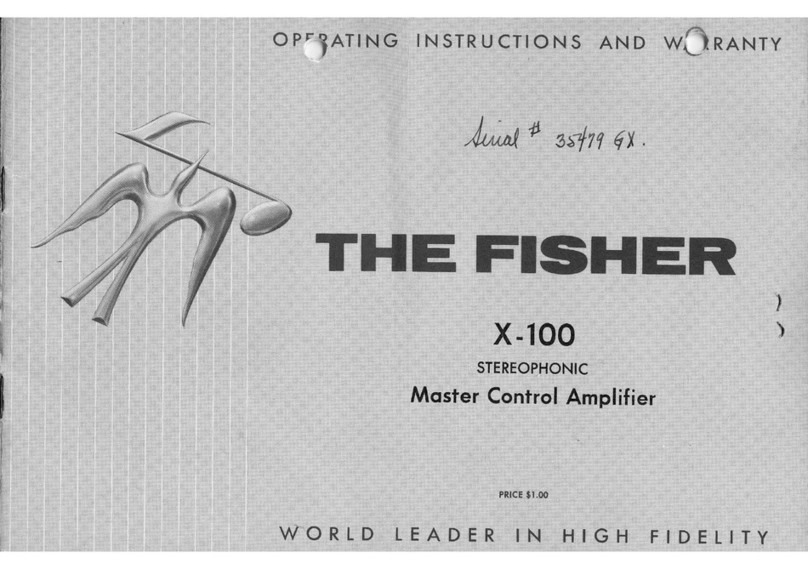
Fisher
Fisher X-100 Operating instructions and warranty

DUB Edition
DUB Edition DUBa11000D Installation & operation manual
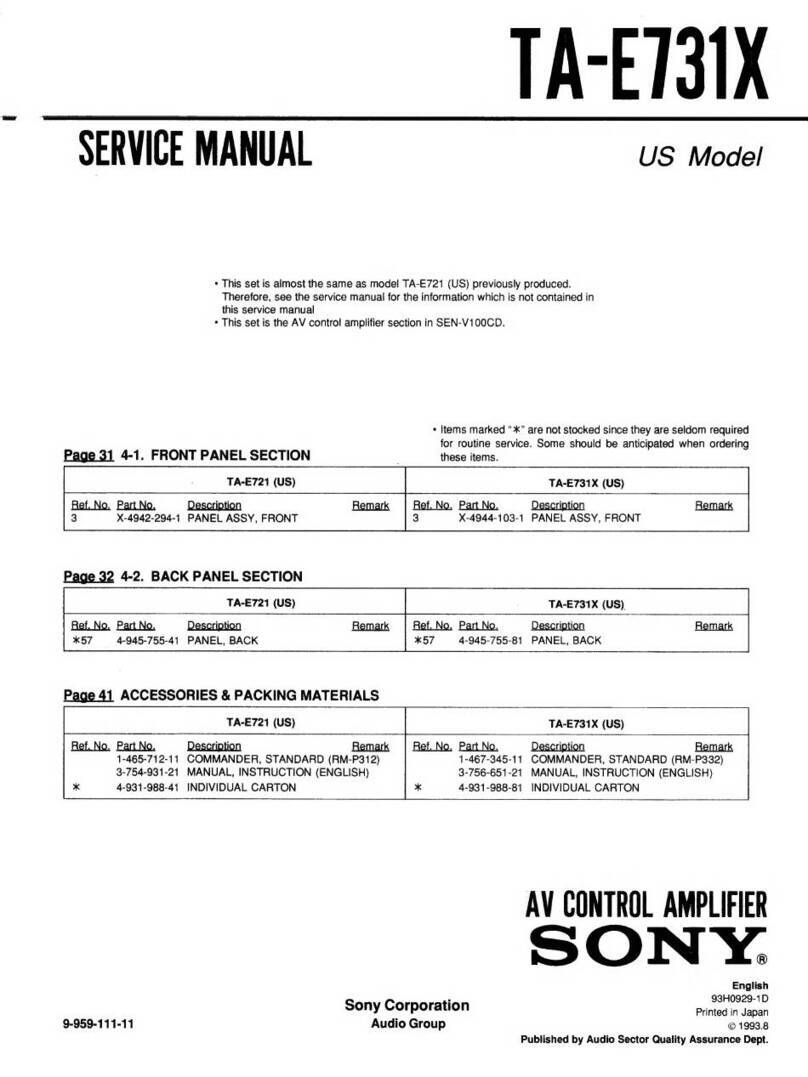
Sony
Sony TA-E731X Service manual
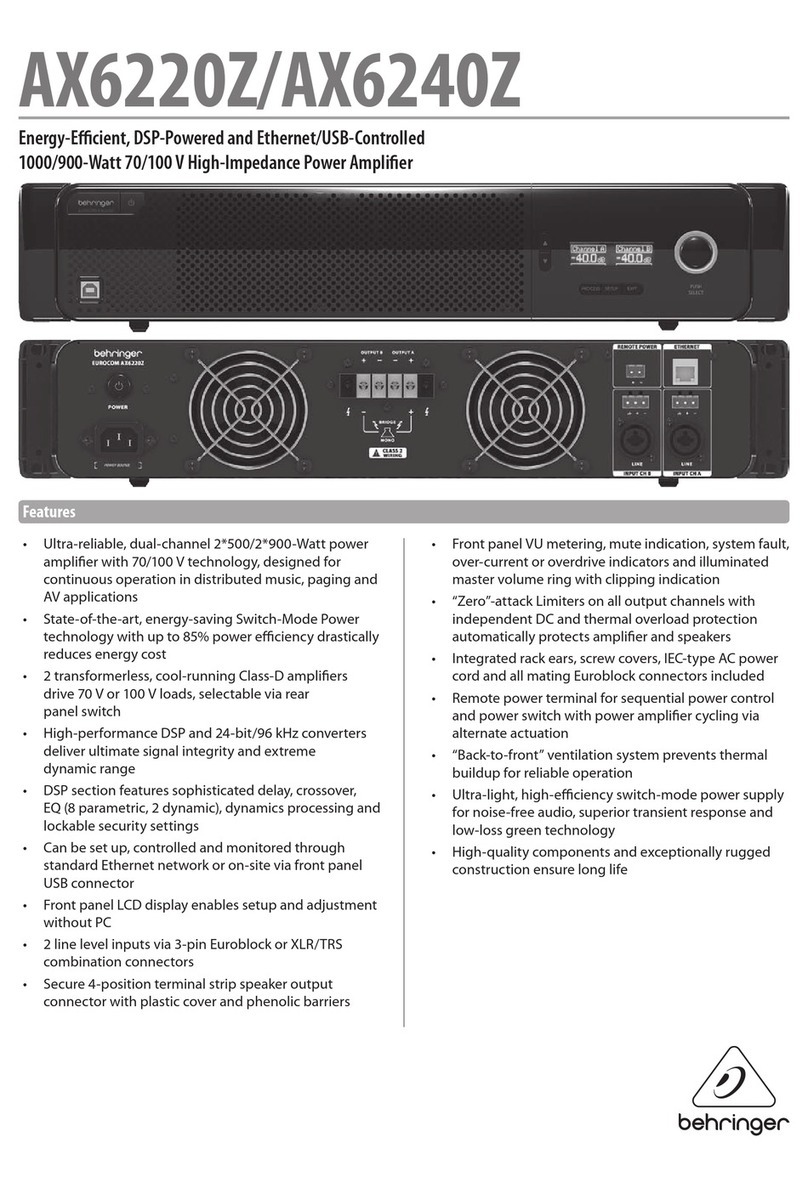
Behringer
Behringer EUROCOM AX6220Z Specifications
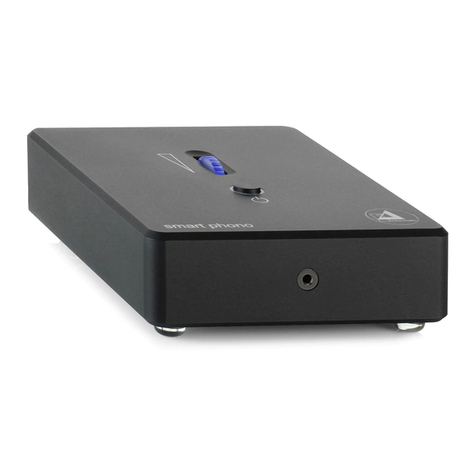
Clearaudio
Clearaudio Smart phono V2 user manual
